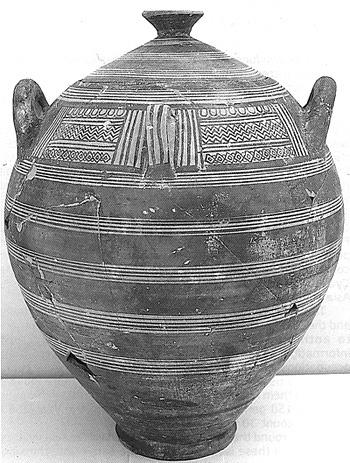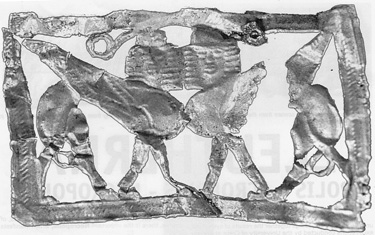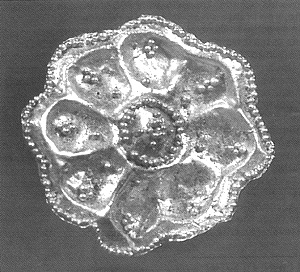 |
|
|
ELEUTHERNA Polis - Acropolis - Necropolis Exhibition at the Museum of Cycladic Art in Athens |
|
 Ivory plaque adorned with scenes from the life of Achilles. Found in leather pouches hanging from iron nails. They were made in Egyptian workshops. |
|
ATHENS- An exhibition at the Museum of Cycladic Art until September 1st, brings together the results of systematic excavations conducted by the University of Crete at ancient Eleutherna over the past 20 years. Located on the northern foothills of Mount Ida, at the heartland of Crete, 25km from the town of Rethymno and 5km from the Monastery of Arkadi (well known for its participation in the Cretan independence war), Eleutherna remains unspoiled by modern development and has been designated as an “area of outstanding natural beauty” (1973) and archaeological interest. Archaeological work on three separate excavation sectors (supervised respectively by Professors P. Temelis, A. Kalpaxis andN. Stampolidis) had yielded hundreds of thousands of finds. Approximately 500 of them made of clay, stone, iron bronze silver, gold, ivory, faience and glass, have been selected to illustrate the long history of the site, which spans at least from the Sub-Neolithic period (4th millenium BC) down to the 12th century AD. |
|
| Unearthed from houses, shrines, temples, forums and cemeteries, the exhibited artifacts shed light on many aspects of public and private life, including religious practices, social and political performance, everyday activities and burial customs. At the same time, they document that, despite population fluctuations, human presence on Eleutherna was uninterrupted throughout the Early, Middle and Late Minoan, Geometric, Archaic, Classical, Hellenistic, Roman, Early Christian and Byzantine periods. Finds from the Polis include parts of life-size statues, pottery of various periods, weapons, tools and jewelry. The Acropolis contributes with figurines, pottery and other items from the shrines, as well as architectural members and several inscriptions bearing testimony to the rules, laws and treaties that governed public life at Eleutherna. And, of course, there is the important Necropolis, which manifests all three known funerary practices: simple inhumations, pithos burials and cremations. |
 Four-handled clay urn with lid 730-710 B.C. It is an import from Knossos which was used as a cinerary urn in the rock-hewn chamber tomb at Orthi Petra. |
Cemeteries are designed to be places of silence, yet very often they manage to speak to us eloquently of the customs of people gone long ago. It is there, more than anywhere else, that lost traditions and ways of life are locked away, waiting to be discovered by archaeologists and interpreted through the meticulous study of artifacts and their contexts. Investigations in the necropolis of Orthi Petra at Eleutherna have rewarded archaeologist with very rich finds, most of which date to the period of the Homeric epics (9th-7th c. BC). This has transformed excavation into a fascinating process of bringing to life the world described in the Iliad and the Odyssey. Fragments of daedalic and archaic statues, a wide range of pottery, tools, jewelry and other artifacts testify to prolific contacts between Eleuthrna and other areas of Crete, the Cyclades, Attica, the Peloponnese, Euboea, the Dodecanese, Asia Minor, Cyprus, the Levantine coast, Egypt. |
|
The charred remains of human bones from cremations and the skeletal material from inhumations have been subject to anthropological examination, yielding important information about the sex and age of the deceased, their occupations and their pathology. Such paleodemographic data helps us approach those ancient people more closely and make them look more familiar. It is an interesting thought that only 150 generations separate us from the year 2500 BC, if we count 30 years per generation. A walk around the Eleuthrna exhibition will enable visitors to explore all these issues, while at the same time thinking of aspects eluding us: the words, the sounds, everything that was gone with the wind and sea, everything that was absorbed in the earth. |
 Cut-out of sheet gold with a representation of two sphinxes in heraldic attitudes. 700-630 B.C. It was foiund in a cinerary run, where it has been placed as a funerary offering. From the rock-hewn chamber tomb in the Orthi Petra necropolis. |
| During the exhibition, the visitors will have the chance to watch a film presenting experimental reconstruction of an ancient cremation, similar to those described by Homer in the Iliad. A detailed exhibition catalogue will be available in Greek and English. The museum will organize educational programs for schoolchildren, as well as guided tours for school groups. |
|
 Gold rosette with granulated decoration. Together with four similar rosettes and eight silver plaquettes decorated with female heads, it formed part of a necklace or diadem interred with the dead woman in an urn burial in the Orthi Petra necropolis. |
|
|
(Greek American Review, Jan. 2005, pp11-12.) |
|
 |
|
|
2000 © Hellenic Communication Service, L.L.C. All Rights Reserved. http://www.HellenicComServe.com |
|